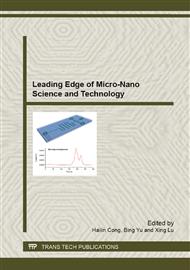[1]
W. Xie, H. Peng, L. Chen, Calcined Mg Al hydrotalcites as solid base catalysts for met hanolysis of soybean oil, J. of Mol. Cat. A: Chemical. 246 (2006) 24-32.
DOI: 10.1016/j.molcata.2005.10.008
Google Scholar
[2]
F. Guo, Z. G. Peng, J. Y. Dai, et al, Calcined sodium silicate as solid base catalyst for biodiesel production, Fuel Processing Technology. 91 (2010) 322-328.
DOI: 10.1016/j.fuproc.2009.11.003
Google Scholar
[3]
Y. B. Fan, C. S. Lu, Y. F. Zhu, et al, Progresses on Iron-based Fischer-Tropsch synthesis catalysts, Zhejiang Chemical Industry. 10 (2009) 18-22.
Google Scholar
[4]
H. Hideshi, Solid base catalysts: generation of basic sites and application to organic synthesis, Applied Catalysis A: General. 222 (2001) 247-259.
DOI: 10.1016/s0926-860x(01)00839-0
Google Scholar
[5]
J. C. A. A. Roelofs, A. J. V. Dillen, K. P. D. Jong, Condensation of citral and ketones using activated hydrotalcite catalysts, Catal. Lett. 74 (2001) 91-95.
Google Scholar
[6]
T. M. Jyothi, T. Raja, K. Sreekumar, Influence of acid–base properties of mixed oxides derived from hydrotalcite-like precursors in the transfer hydrogenation of propiophenone, J. Mol. Catal. 157 (2000) 193-198.
DOI: 10.1016/s1381-1169(99)00439-2
Google Scholar
[7]
Y. J. Wang, Q. X. Zeng, C. G. Feng, Carriers for vehicle tail-gas purification catalysts, Industrial Catalysis. 7 (1999) 3.
Google Scholar
[8]
Z. Y. Ma, C. Yang, W. Wei, et al, Preparation and surface properties of different zirconia polymorphs, Acta Phys. Chim. Sin. 20 (2004) 1221-1225.
Google Scholar
[9]
W. L. Xie, H. Peng, L. G. Chen, Transesterification of soybean oil catalyzed by potassium lead on alumina as a solid-base catalyst, Applied Catalysis A: General. 300 (2006) 67-74.
DOI: 10.1016/j.apcata.2005.10.048
Google Scholar
[10]
S. Furuta, H. Matsuhashi, K. Arata, Biodiesel fuel production with solid amorphous-zirconia catalysis in fixed bed reactor, Biomass and Bioenergy. 30 (2006) 870-873.
DOI: 10.1016/j.biombioe.2005.10.010
Google Scholar
[11]
G. Pacheco, J. J. Fripiat, Physical chemistry of the thermal transformation of mesoporous and microporous zirconia, J. Phys. Chem. B. 104 (2000) 11906-11911.
DOI: 10.1021/jp001455d
Google Scholar
[12]
Y. J. Wang, Y. F. Ying, P. Fang, et al, PrOy-ZrO2 solid Solution: characterization and catalytic oxidation of CO, Chinese Journal of Inorganic Chemistry. 7 (2006) 1251-1256.
Google Scholar
[13]
Y. X. Zhu, W. Zhuang, D. E. Jiang, et al, The basicity and dispersion state of alkaline earth metal compounds on the surface of ZrO2, Chinese Journal of Catalysis. 21 (2000) 34-35.
Google Scholar
[14]
S. G. Chen, Y. S. Yin, C. H. Zhou, Application and study on the mechanism of the phase-stabilized zirconia, Bulletin of the Chinese Ceramic SocIety. 3 (2004) 73-76.
Google Scholar
[15]
C. H. Liu, S. Y. Huang, W. Wei, et al, Preparation of mesoporous MgO-ZrO2 nanocomposites, a new solid base, and its catalytic performance, Modern Chemical Industry. 27 (2007) 35-37.
Google Scholar
[16]
M. A. P. J. Hacking, F. V. Rantwijk, R. A. Sheldon, Lipase Catalyzed reactions of aliphatic and arylaliphatic carbonic acid esters, J. Mole. Cata1. B: Enzy. 9 (2000) 201-208.
DOI: 10.1016/s1381-1177(99)00097-1
Google Scholar
[17]
S. Gryglewiez, F. A. Oko, G. Gryglewiez, Synthesis of modern synthetic oil based on dialkyl carbonates, Ind. Eng. Chem. Res. 42 (2003) 5007-5009.
DOI: 10.1021/ie030322m
Google Scholar
[18]
Q. Ouyang, G. Li, The preparation of high carbon alcohol carbonate, Synthetic Lubricants. 22 (1995) 1-5.
Google Scholar
[19]
M. J. Li, Z. C. Feng, C. Li, Phase transformation in the surface region of zirconia detected by UV Raman spectroscopy, J. Phys. Chem. B. 105 (2001) 8107-8111.
DOI: 10.1021/jp010526l
Google Scholar
[20]
H. B. Guan, J. Liang, Y. X. Zhu, et al, Structure characterization and monolayer dispersion phenomenon of MgO-ZrO2 prepared by co-precipitation, Acta. Phys. Chim. Sin. 21 (2005) 1011-1106.
Google Scholar
[21]
K. T. Jung, A. T. Bell, The effects of synthesis and pretreatment conditions on the bulk structure and surface properties of zirconia, Journal of Molecular Catalysis A: Chemical. 163 (2000) 27-42.
DOI: 10.1016/s1381-1169(00)00397-6
Google Scholar
[22]
Y. S. Cai, D. M. Tong, X. Wu, et al, The effect of sulfa ting agents and preparation methods on the structure and properties of zirconium-based solid acid catalysts, Chemical Research and Application. 20 (2008) 996-1000.
Google Scholar
[23]
H. Y. Cui, H. S. Tian, Y. F. Zhu, et al, Study on catalysts for transesterification synthesis of dimethyl carbonate, Guang dong Chemical Industry. 36 (2009) 52-54.
Google Scholar
[24]
G. J. Dong, T. Li, Characterization and preparation of zirconia-supported MgO and its use in di-2-ethylhexyl carbonate synthesis, Fine Chemicals. 26 (2009) 166-169.
Google Scholar


